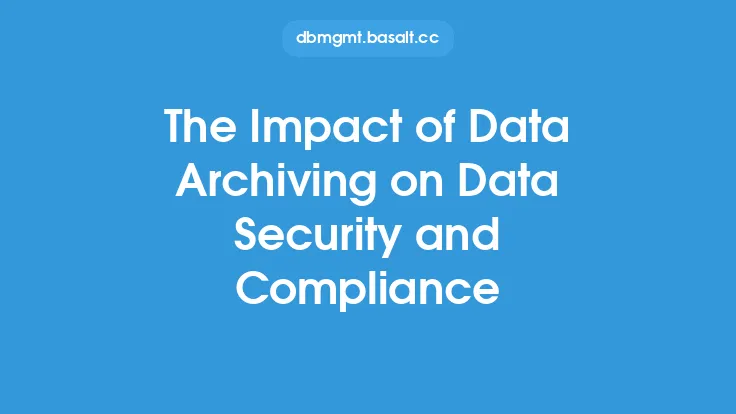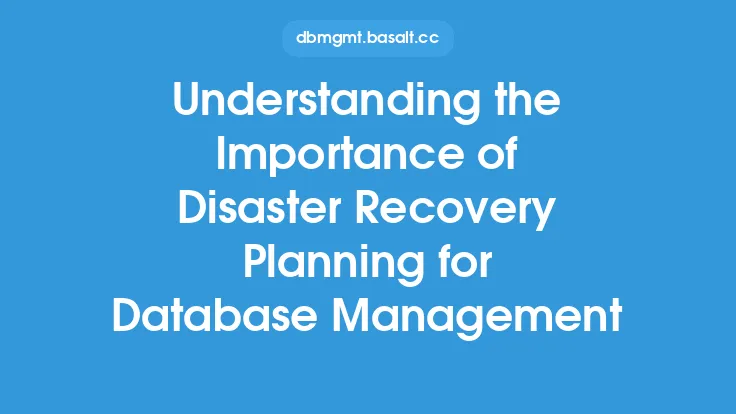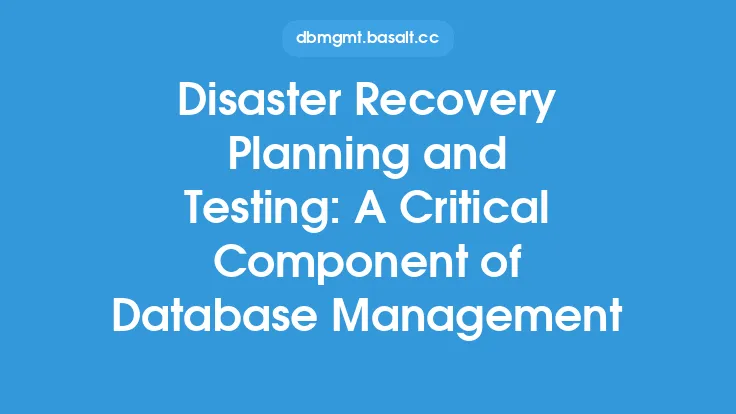Disaster recovery planning is a critical aspect of database management, as it ensures the continuity of business operations in the event of a disaster or major disruption. One of the key areas where disaster recovery planning has a significant impact is on database security and compliance. In this article, we will explore the relationship between disaster recovery planning and database security and compliance, and discuss the ways in which a well-planned disaster recovery strategy can help protect sensitive data and ensure regulatory compliance.
Introduction to Database Security and Compliance
Database security and compliance are critical components of database management, as they ensure the confidentiality, integrity, and availability of sensitive data. Database security refers to the measures taken to protect databases from unauthorized access, use, disclosure, disruption, modification, or destruction. Compliance, on the other hand, refers to the adherence to regulatory requirements and industry standards that govern the handling and protection of sensitive data. Some of the key regulations and standards that databases must comply with include the General Data Protection Regulation (GDPR), the Health Insurance Portability and Accountability Act (HIPAA), and the Payment Card Industry Data Security Standard (PCI DSS).
The Impact of Disaster Recovery Planning on Database Security
Disaster recovery planning has a significant impact on database security, as it ensures the continuity of business operations in the event of a disaster or major disruption. A well-planned disaster recovery strategy can help protect sensitive data from unauthorized access, use, disclosure, disruption, modification, or destruction. This is achieved through the implementation of measures such as data backup and replication, which ensure that sensitive data is available and accessible in the event of a disaster. Additionally, disaster recovery planning involves the identification and mitigation of risks, which can help prevent security breaches and other security incidents.
The Role of Disaster Recovery Planning in Ensuring Compliance
Disaster recovery planning also plays a critical role in ensuring compliance with regulatory requirements and industry standards. A well-planned disaster recovery strategy can help ensure that sensitive data is handled and protected in accordance with regulatory requirements, which can help prevent non-compliance and the associated penalties. For example, the GDPR requires organizations to implement measures to ensure the confidentiality, integrity, and availability of personal data, which can be achieved through the implementation of a disaster recovery plan. Similarly, the HIPAA requires healthcare organizations to implement measures to ensure the confidentiality, integrity, and availability of protected health information, which can be achieved through the implementation of a disaster recovery plan.
Technical Considerations for Disaster Recovery Planning
From a technical perspective, disaster recovery planning involves the implementation of measures such as data backup and replication, which ensure that sensitive data is available and accessible in the event of a disaster. This can be achieved through the use of technologies such as disk-based backup, tape backup, and cloud-based backup. Additionally, disaster recovery planning involves the implementation of measures such as server virtualization, which can help ensure the continuity of business operations in the event of a disaster. Other technical considerations for disaster recovery planning include the implementation of measures such as network redundancy, power redundancy, and cooling redundancy, which can help prevent downtime and ensure the continuity of business operations.
Best Practices for Implementing a Disaster Recovery Plan
To ensure the effectiveness of a disaster recovery plan, it is essential to follow best practices such as conducting regular risk assessments, implementing measures to prevent downtime, and testing the plan regularly. Additionally, it is essential to ensure that the plan is aligned with business objectives and is communicated to all stakeholders. Other best practices for implementing a disaster recovery plan include ensuring that the plan is flexible and adaptable, and that it takes into account the organization's specific needs and requirements.
Conclusion
In conclusion, disaster recovery planning has a significant impact on database security and compliance, as it ensures the continuity of business operations in the event of a disaster or major disruption. A well-planned disaster recovery strategy can help protect sensitive data from unauthorized access, use, disclosure, disruption, modification, or destruction, and ensure regulatory compliance. By following best practices such as conducting regular risk assessments, implementing measures to prevent downtime, and testing the plan regularly, organizations can ensure the effectiveness of their disaster recovery plan and protect their sensitive data. Additionally, by taking into account technical considerations such as data backup and replication, server virtualization, and network redundancy, organizations can ensure the continuity of business operations in the event of a disaster.





